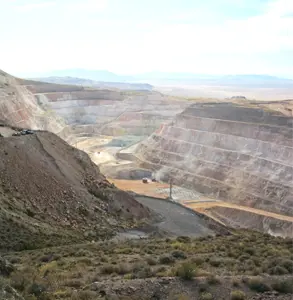The Jerritt Canyon mine tailings storage facility (TSF1) located in northeast Nevada was commissioned in 1980 and operated through 2013 for the disposal and containment of spent tailings slurry from the Jerritt Canyon milling operations. TSF1 was designed in seven phases as a ring dike impoundment constructed over partially compacted native soils without a synthetically-lined containment system.
Tailings were typically deposited from its outer perimeter creating a pronounced conical depression in the center of the impoundment. Throughout most of its operations, this depression was used to store approximately 500 million to more than 800 million gallons of surplus supernatant water.
As a result, seepage from TSF1 was detected in the alluvium in 1987, when a recharge mound and migration of tailings supernatant solution with elevated total dissolved solids and chloride concentrations were detected beneath the impoundment. Since then, dozens of pumpback, freshwater infiltration, and monitoring wells were installed surrounding TSF1 in an attempt to manage and mitigate the seepage plume.
In 2011, in an effort to completely evacuate supernatant inventories from TSF1 and prepare for closure, Jerritt Canyon began transferring remaining TSF1 supernatant to the newly-constructed water storage reservoir. This is a double-lined pond designed to contain approximately 380 million gallons of surplus solution. By the middle of 2014, the TSF1 supernatant pool was completely removed by pumping to the water storage reservoir.
As a direct result of these actions, seepage collection and removal reduced from 900 to approximately 600 gpm, reducing the recharge mound and lowering the groundwater table beneath TSF1. As a result, this caused numerous pumpback wells to dry up.
SRK originally submitted a final plan for permanent closure (FPPC) for TSF1 to the Nevada Division of Environmental Protection (NDEP) in 2010. During its preliminary development, SRK evaluated store-and-release covers that primarily rely on evapotranspiration from plants to limit infiltration versus synthetic-lined covers. They were considered inadequate, since most Jerritt Canyon precipitation occurs as winter snow and snowmelt and infiltration occurs while plants remain dormant in spring.
Therefore, a synthetically-lined geomembrane cover design, approved by NDEP in 2011, was selected to 1) preclude any meteoric infiltration into the underlying tailings and 2) eliminate the driving hydraulic head causing continued migration of contaminates into underlying vadose zone and groundwater.
The FPPC closure cover consists (from bottom to top) of an interim working platform layer, 40-mil HDPE geomembrane, and a 3-foot-thick alluvial-type growth media cover. It slopes towards the southern end of the impoundment where controlled stormwater runoff drains off the facility in a controlled manner through an outflow spillway into an existing stormwater diversion channel.








